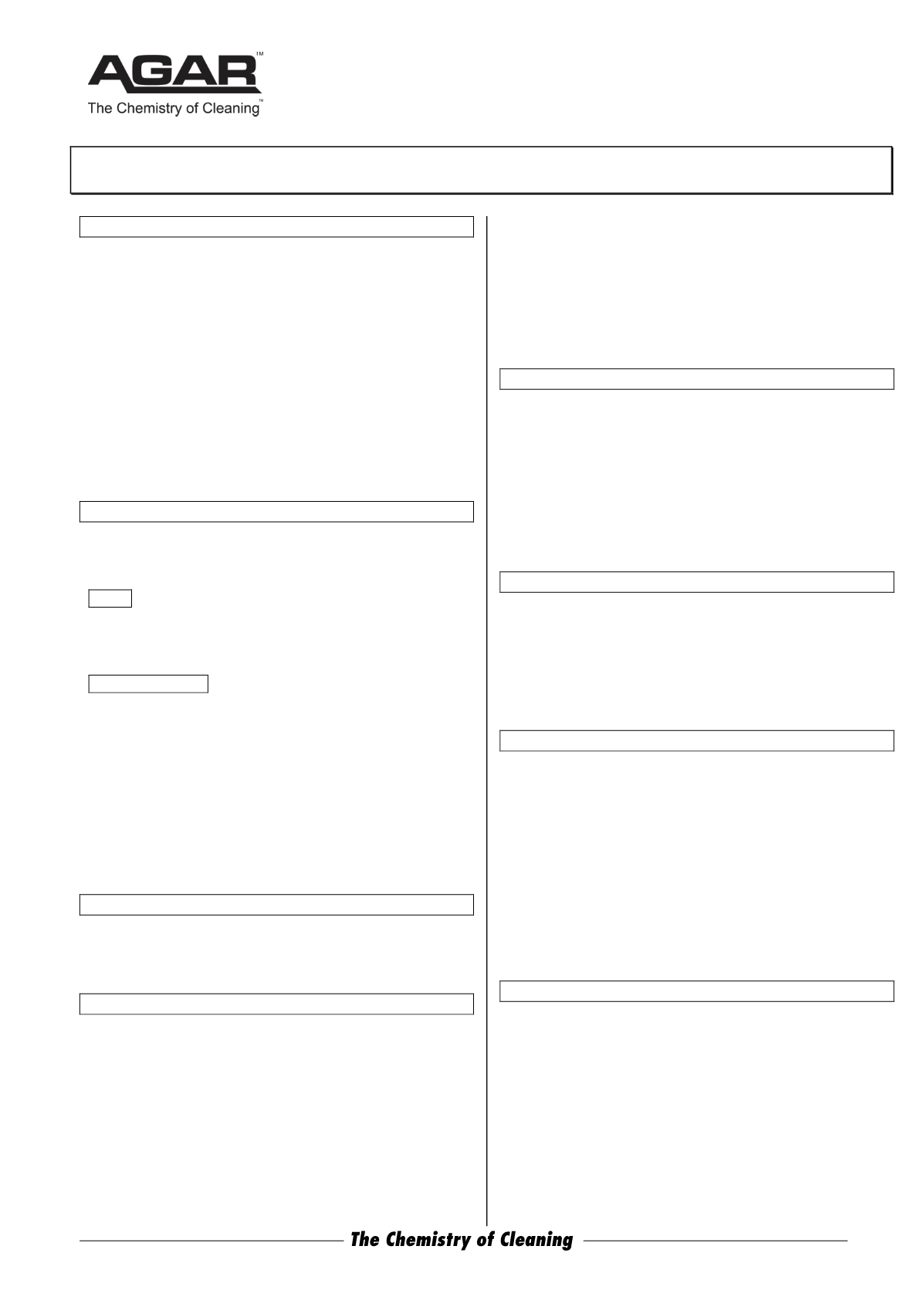

ABN 80 004 726 890 | MADE IN AUSTRALIA
VIC 03 9480 3000
NSW 02 9743 6020
SA 08 8293 2020
QLD 07 3274 3438
WA 08 9249 4566
Safety Data Sheet
Issued: November 18, 2014
Page 1 of 2
ISOPROPYL ALCOHOL
1 IDENTIFICATION OF THE MATERIAL AND SUPPLIER
Product Name:
ISOPROPYL ALCOHOL
Other Names: Propan-2-ol, 2-propanol, Isopropanol
Manufacturer's Product Code: ISO5
Product Use: Industrial solvent. Cleaning and degreasing.
COMPANY DETAILS
Company: Agar Cleaning Systems Pty. Ltd.
Address: 12-14 Cope Street, Preston, Vic. 3072
Telephone: 03 9480 3000 Facsimile: 03 9480 5100
Web:
www.agar.com.auAgar SDS are available from this website.
E-mail:
sales@agar.com.auEmergency Telephone Number: 131 126
(Aust wide)
2 HAZARDS IDENTIFICATION
Hazardous according to criteria of Safe Work Australia.
Irritant Xi. Classed as Dangerous Goods.
Risks:
Irritating to eyes. [R36]
Highly flammable. [R11]
Vapours may cause drowsiness and dizziness. [R67]
Safety Directions:
Keep container tightly closed and in a well-
ventilated place. [S7/9]
Keep away from sources of ignition – No
smoking. [S16]
Avoid contact with skin and eyes. [S24/25]
Take precautionary measures against static
discharges. [S33]
In case of contact with eyes, rinse immediately
with plenty of water and seek medical advice. [S26]
In case of fire, use sand, earth, chemical powder
or alcohol type foam. [S43B]
3 COMPOSITION / INFORMATION ON INGREDIENTS
Ingredients:
Chemical Entity: CAS No.: Proportion:
Isopropyl alcohol
67-63-0
> 98%
4 FIRST AID MEASURES
Poisons Information Centre: Phone 131 126
Swallowed:
If poisoning occurs, contact a doctor or Poisons
Information Centre (Ph 131 126 Aust. wide). If swallowed, do
NOT induce vomiting. Keep at rest. Seek immediate medical
attention.
Eye:
Flush eyes with large amounts of water until irritation
subsides. Seek immediate medical attention.
Skin:
Flush area with large amounts of water and wash area
with soap if available. Remove contaminated clothing,
including shoes, and launder before reuse. Seek medical
attention for skin irritations.
`
Using proper respiratory protection, immediately remove the
affected victim from exposure. Administer artificial respiration
if breathing is stopped. Keep at rest. Seek immediate medical
attention.
First Aid: Provide eye baths and safety showers.
Medical Attention: Treat according to symptoms. Avoid gastric
lavage. Risk of aspiration of product to the lungs with the
potential to cause chemical pneumonitis.
5 FIRE FIGHTING MEASURES
Fire/Explosion Hazard:
Isopropyl
Alcohol is flammable.
Fire Extinguishing Media: Water spray or fog. Foam.
Fire Fighting PPE: Wear breathing apparatus and protective
gloves.
Special Fire Fighting Procedures: None.
Unusual Fire Hazards: None.
Hazardous products of combustion: Thermal decomposition in a
large fire may yield toxic fumes, including carbon dioxide and
carbon monoxide.
6 ACCIDENTAL RELEASE MEASURES
Eliminate sources of ignition.
Clean up and report all spills immediately. Contain spill and mop
up. Contain leaking packaging in a containment drum.
Prevent escape to drains and waterways.
Prevent vapours from building up in confined areas.
7 HANDLING AND STORAGE
Storage and Transport: Do not open near open flame, sources
of heat or ignition. No smoking. Keep container closed. Handle
containers with care. Open slowly to control possible pressure
release. Use grounding leads to avoid discharge (electrical
spark).
Store in a cool, dry place away from direct sunlight. Do not
pressurise, cut, heat or weld containers – residual vapours are
flammable.
Incompatibility (materials to avoid for purposes of transport,
handling and storage only): Natural Rubber, Butyl Rubber,
EPDM, Polystyrene.
8 EXPOSURE CONTROLS / PERSONAL PROTECTION
Exposure Standards: TWA: 983 mg/m³ (400 ppm)
STEL: 1230 mg/m³ (500 ppm)
Engineering Controls: Mechanical ventilation: Not required
except in confined areas.
Personal Protection:
Gloves - Wear chemical resistant gloves (e.g., PVC) if
prolonged or repeated skin contact is anticipated.
Eye Protection - Safety glasses or face shield.
Other – Half-face filter mask if concentrations are likely to
exceed National Exposure Standards.
Please turn to page 2.


















